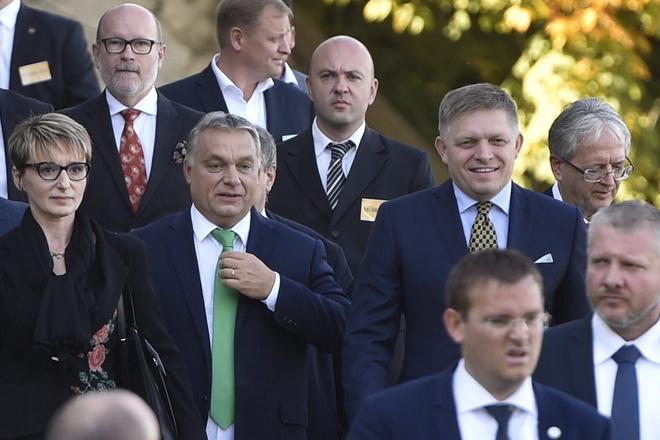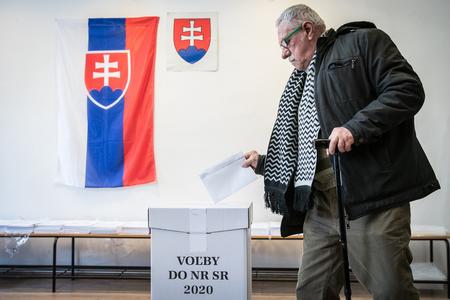The Smer party, chaired by former Slovak prime minister Robert Fico, and Fidesz, led by Hungarian Prime Minister Viktor Orbán, achieved almost an identical election victory in the past.
In 2012, Smer won the parliamentary election with 44.5 percent. Fidesz won the parliamentary election two years later, harvesting 45 percent of the votes.In 2012, Smer won the parliamentary election with 44.5 percent. Fidesz won the parliamentary election two years later, harvesting 45 percent of the votes.
However, Smer was still forced to seek support in the opposition when amending the Constitution and adopting constitutional laws, while Orbán, with a constitutional majority in parliament, controlled Hungary. How is it possible? In 12 years of continuous rule, Orbán has transformed the electoral system after his own image.
While the proportional electoral system in Slovakia gives the winner of a parliamentary election about as many seats in parliament as their electoral gain, in Hungary the mixed majority system significantly favours the strongest party.
That is why Fidesz managed to rule with the constitutional majority in 2014 again, although the party was elected by 600,000 people fewer than four years earlier.
After the April 3 parliamentary election, Fidesz will occupy two-thirds of all parliamentary seats for the fourth time in a row, although half of the electorate voted for the party.
If the increasingly popular extremists from Republika, Smer or Hlas, want to get inspired by Orbán's success after the next parliamentary election, one amendment with the support of the simple majority would be enough for them to introduce the same system in Slovakia.
In an interview, political scientist PAVOL BABOŠ from Comenius University Bratislava describes how, for example, a simple increase in the threshold for entry into parliament can create a single-party government in Slovakia, but also how the most popular parties - OĽaNO, Smer, or HZDS – actually won parliamentary elections in the past without needing to implement a similar system as seen in Hungary.
If Smer and the extremists won a majority in the next election, would it be difficult for them to stay in power by manipulating electoral rules, as Viktor Orbán did?
For example, they could increase the quorum for political parties needed to enter parliament, say from today's 5 percent to 10. They would just need a simple majority, no more than 76 votes, to pass such a change in parliament.
According to current polls, a maximum of three or four parties would get into parliament. For example, if Hlas won 20 percent, Smer and SaS had 10 percent and the others had even less, Hlas would obtain about 75, maybe 76, parliamentary seats. Hlas would need no partner to rule the country.
Would nothing prevent such a change? Would the will of most MPs suffice?
Although the electoral system is not addressed in the Constitution, but only in common law, the Constitution presupposes a certain proportionality. Theoretically, the Constitutional Court can assess whether the change affects this principle.
The Czech Constitutional Court has similar powers.
How else could Slovak parties be inspired by Orbán to increase their electoral gain with only a small change in the electoral system? Fidesz, for instance, allowed Hungarians who do not live in Hungary to vote from abroad.
A very simple change would be to simplify voting by post from abroad. However, it would help pro-European and pro-Atlantic parties in cases where an election is tight.
The coalition Progresívne Slovensko and Spolu lacked several hundred votes in the 2020 election. If the coalition had won them, it would probably have brought them closer to overcoming the quorum. However, such changes cannot make any party a hegemon, such as Fidesz in Hungary.
If Orbán's winning scenario could only be achieved by moving to the majority electoral system, why has no Slovak political party implemented it to date?
Politicians and their parties have long been learning how to make the most of the current system, in which the whole of Slovakia is one constituency, and the same candidates are elected from east to west.
If a political party can win in the current system, after the change no one can guarantee that it will turn out just as well.
It is easier to lead a party from Bratislava with a narrow circle of leaders than to have complex structures where different regional leaders will compete with each other.“
It depends on a combination of a number of factors. How many MPs would be elected in each constituency, how many rounds a parliamentary election would be comprised of, whether parties or individual candidates would be elected, and whether voters could choose more than one candidate and from different parties.
In addition, any change in the electoral system can significantly change voter behaviour.
After the parliamentary election in 2006, political scientist Jozef Ružarovský recalculated the results as if the majority electoral system applied. According to his calculations, Smer did not win 50 seats, but 99 and could rule alone with the constitutional majority. Would it not work according to this pattern?
It is not that simple. In the current system, voters in Svidník, Brezno and Trenčín will find the same politicians, including Robert Fico, on the list of candidates.
The system you have outlined assumes a large number of constituencies. Let's say there are 79 of them, copying the number of Slovak districts.
A party would suddenly need 79 different leaders for each district, and Robert Fico, Igor Matovič (OľaNO chair) and Richard Sulík (SaS chair) could be voted for in only one of them, where they have a permanent residence.
Political parties are not ready for this. Therefore, they have not attempted to change the electoral system.
Fidesz has managed to bring up recognisable leaders across the country over the years. In Slovakia, we are half a year before another municipal election. Most parties do not yet have candidates to at least run in the largest cities. It is a sign of their staffing shortage.
Parties like SaS and OĽaNO have a minimum number of members. But what about parties with thousands of members like Smer or the Christian Democratic Movement (KDH)?
There is a difference between having members and regional leaders. I have noticed only two leaders for the KDH - the mayor of Prešov and the chair of the Prešov Region.
In the majority system, the KDH could gain more councillors in the Prešov Region than before, but perhaps nowhere else.
Does this also apply to Smer or Hlas, which are presented at press conferences by a handful of the same faces on a regular basis?
Yes. I will use the example from Humenné, eastern Slovakia. Smer won the last parliamentary election there, but Jana Vaľová from Smer could not defend her mayorial position in the last municipal election.
In the case of the parliamentary election, Smer voters in Humenné could choose Fico as their candidate, while in the municipal election, Smer's candidate as a regional leader failed, even though she had been mayor multiple times.
It shows how voters behave differently in a different locality under a different electoral system, and why even large parties would not be sure they would repeat the success of Fidesz thanks to the new election rules.
New parties in Slovakia, which try to get into parliament, often propose to change the electoral system. When they succeeded, they always abandoned the change. Does that mean they are comfortable with the system?
Viktor Orbán's success has been based on the systematic control of Hungary.“
Slovak parties are centralised and built on one or a small number of leaders known to voters. It is easier to lead a party from Bratislava with a narrow circle of leaders than to have complex structures where different regional leaders will compete with each other.
For the parties, a change in the electoral system also means a fragmentation of the centres of power. An electorally strong region will therefore be stronger in enforcing demands that other regions or party headquarters may not agree with.
Robert Fico proposed in 2001, after the founding of Smer, to change the proportional system to the majority system with 150 constituencies. This would mean electing one MP in each constituency with around 35,000 voters. What would it do to political parties if he did not abandon the idea and push it through?
This would force the parties to raise local leaders. Even in an average Slovak town, there would have to be more than one leader.
As each such leader would represent their own interests in the region in order to succeed in the next election, the formation of government coalitions at the national level could become very challenging after the election.
The same system operates in the United Kingdom, where it has set up a two-party system. The Conservatives and the Labourists are the main players in the election. Would Smer or Hlas not compete against any right-wing party in Slovakia?
OĽaNO, Progresívne Slovensko or SaS would continue to dominate in large cities. There are regions where KDH is strong. A few years ago there were regions where the Communist Party of Slovakia would have succeeded under these rules.
In southern Slovakia, political parties representing the Hungarian minority, which are not currently in parliament, would be successful.
I cannot imagine that two big parties would emerge in Slovakia to authentically cover all the problems in society and represent them in all 150 constituencies.
Big parties arise when problems are evenly distributed across the country, which is not the case in Slovakia. It is not in the power of one big party to cover such diverse agendas in every corner of the country.
Now the Association of Towns and Municipalities of Slovakia is trying to promote a higher regional representation of MPs in parliament. This is to be achieved through the creation of several constituencies. It would not be 150, but only eight by region. Would the biggest parties not benefit from this less radical system?
This proposal is similar to the system that works in the Czech Republic. The leaders of individual regions take part in television discussions, and even those topics they discuss are different. Other things bother people around Prague, and other problems bother people in Silesia. It would work similarly in Slovakia.
The system would suit the parties that would be able to serve all these regions well with their policies. And here may be the reason why no one supports this proposal.
It would bring considerable uncertainty for the parties into the political future. They would not even know how the media would behave.
What do you mean?
What if Robert Fico wanted to partake in a TV debate for every region, even where he would not run? Would they let him take part in it? How would a voter react to this if they saw Igor Matovič on television, but his name would not be on all the lists of candidates except for one?
For years, the way in which constituencies are drawn has also contributed to Fidesz's success in Hungary. The aim is for Fidesz voters to be represented in as large a number as possible. If Slovakia were to be divided into more constituencies, how would Slovak parties want to draw them?
For example, a Slovak politician will always try to draw constituencies so that the Hungarian minority does not have a majority in them, and such a politician has a chance to be elected.
The Smer political party could simply be satisfied that the constituencies with large rich cities would also include a large area with a large number of villages and a less rich population. A candidate pursuing a left-wing redistribution policy and support for socially disadvantaged people would always win there.
It is not always possible, but where possible, they would try to do it this way.
To what extent can political space be controlled only by changing the electoral system? For example, to reach the constitutional majority, when a political party might already threaten the democratic system?
It takes more than a change in the electoral system, but it can be the beginning.
Orbán's success has been based on the systematic control of Hungary. He has used practices beyond democratic principles such as media control, political clientelism, electoral corruption, voter buying, social measures and vicious rhetoric that creates an enemy.
How Orbán changed Hungary's electoral system:
Hungary introduced a mixed electoral system in 1989, when a voter cast one vote in their constituency for a particular candidate (only the first in order wins) and the other vote was given to a political party on one of several regional lists of candidates.
In 2011, Fidesz adjusted the rules with several major changes.
When electing specific candidates, more than 50 percent of voters no longer have to vote for the winner. The winning candidate only needs to get the most votes. This helps the most popular party even in more balanced constituencies.
One national list of candidates was created when it comes to the election of political parties, so the parties need lesser-known leaders.
The system of redistribution of lost votes from elections in single-member constituencies has changed. As votes for all but the winning candidate were lost in the elections in these constituencies, they were initially redistributed among the parties of the unsuccessful candidates. Today, some of the votes lost in this way are also redistributed to the winner's party.
In addition to these direct changes, Fidesz also pushed for voting from abroad by Hungarians with no permanent residence in the country.
© Sme







